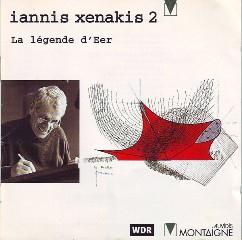Iannis Xenakis - La Légende d'Eer (1995)
Iannis Xenakis - La Légende d'Eer (1995)

1. La Légende d'Eer (The Legend of Eer) Iannis Xenakis – composer, performer
La Légende d'Eer (1977-1978) was composed when Iannis Xenakis was in the midst of his far-reaching explorations of mythology and philosophy. Variously inspired by Plato's myth of Er in The Republic, Pascal's Pensées, and even an article on supernovas in Scientific American, this piece transcends programmatic considerations and presents a strange, roiling soundscape that dwarfs Xenakis' earlier electro-acoustic efforts in scope and imagination. This astonishing piece begins with an extended passage of penetrating, shrill tones that break up into unevenly staggered and twittering pulses. These gradually widen into thick bands of gliding microtonal clusters and bulging intrusions of processed noise, harsh percussive attacks, and throbbing ostinati that grow in density and intensity, only to thin out by the end in distant, glassy pitches similar to the opening. The cumulative effect is similar to the immense roar of Xenakis' Bohor (1962), a shimmering congeries of metallic and rumbling tones that, for its time, seemed the ultimate expression of cosmic vastness and chaos. More than twice Bohor's length, La Légende is also richer in its materials and more polymorphous in its extended processes. Recommended for adventurous listeners and serious students of musique concrète, this CD poses extreme challenges and offers its rewards only to the most dedicated explorers. ---Blair Sanderson, AllMusic Review
In applying mathematical and physical laws to the composition of music, Iannis Xenakis exposed the implicit connections between science and art -- rooted in theories of statistical probability, his stochastic method revolutionized not only the composition of music but also its performance, exploring the boundaries of sound and space. Born of Greek parentage in Braïla, Romania on May 29, 1922, Xenakis returned to Greece at age ten, later studying engineering at Athens Polytechnic University. He relocated to Paris in 1947, honing his skills as a composer under the tutelage of Honegger, Milhaud and Messiaen, and in 1954 completed his first major work, Metastasis for Orchestra. For over a decade Xenakis also worked with the renowned French architect Le Corbusier, most notably contributing to the design of the Philips Pavilion for the 1958 Brussels International Fair.
Xenakis' engineering studies and architectural work directly impacted his musical ideas (and vice versa) -- on the belief that composition develops outside of music, he built upon mathematical and philosophical principles to develop his stochastic theory (adapting the name from "stochos," the Greek word for "goal"). Xenakis explored the inner structural organization of composing, applying theories of statistical probability to discover the interrelationships between organized sound and music; with the advent of computer technology, he translated his findings into programs which created new compositional families. Xenakis broke further ground in his studies of spatial dynamics -- positioning musicians throughout an auditorium according to kinetic principles, he pursued a perfect sonic balance based upon the distribution of sound from a multitude of directions.
Works including 1956's Pithoprakta and 1957's Diamorphoses launched Xenakis to the forefront of the avant-garde, and he continued pushing the envelope with subsequent pieces including 1958's Duel (a composition based on the principles of game theory) and 1962's Bohor (his first major electronic project). As the complex rhythms of ensemble compositions like 1963's Eonta gave way to full-blown orchestral scores including 1969's Oresteia, in the interim Xenakis directed much of his energies towards guiding the Centre d' Études de Mathématique et Automatique Musicales (CEMAMu), which he founded at the Sorbonne in 1966. Although his oeuvre includes works for ballet and theater, tape constructions and even vocal music, from the mid-'70s onward the majority of Xenakis' compositions grew from orchestral and instrumental origins. After suffering poor health for some years, Iannis Xenakis died at his home in Paris on February 4, 2001. ---Jason Ankeny, itunes.apple.com
download (mp3 @320 kbs):








